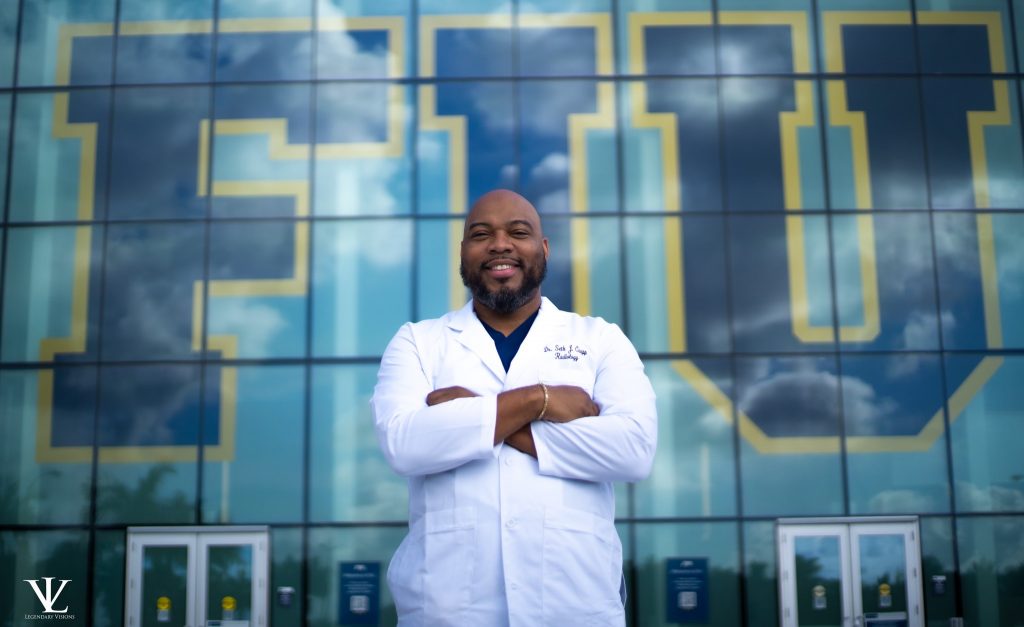–By Nina Rose
“Do I belong here?”
Look around the classroom. Few of the students look like you, and many come from families of doctors. The faculty don’t look like you, and the school’s culture may communicate that you don’t belong. How are you going to find mentors, build a network? Only a tiny percentage of U.S. doctors share your race or ethnicity, and even fewer are in your chosen specialty.
That question of belonging may be posed by some medical students, as the road to medical school is far less traveled by students from minority backgrounds. That’s why Dr. Seth Crapp ’98 established an endowed first-generation scholarship to help pave the way for Black or African American students pursuing premedical studies. He hopes to give FIU students a financial boost toward the profession while also raising awareness about why diversity in medicine matters and what we need to do to make it happen.
“Five percent of physicians in the United States are Black or African American. That is a very small percentage when you consider that we make up 13 percent of the population. Research shows that patients have better health outcomes when treated by a physician who looks like them. If we know that increasing diversity among physicians overall can give us better patient outcomes, then that is something we should be working on,” said Dr. Crapp.
First doctor in the family
Raised by parents who attended Ivy League institutions such as Harvard, Princeton and Mount Holyoke, it was not really a question of whether Dr. Crapp would go to college. But he would be the first person in his extended family to become a medical doctor.
Always interested in the sciences, Dr. Crapp attended Miami Northwestern, a predominantly Black high school, and learned about FIU through a college-readiness program called Partners in Progress. An invitational scholar with a full academic scholarship and several college credits under his belt, Dr. Crapp enrolled at FIU to pursue a bachelor’s degree in chemistry. His goal was to become a doctor. Dr. Crapp applied to several medical schools and chose Meharry Medical College in Nashville, Tennessee, a historically Black medical school.
Once there, Dr. Crapp learned that he didn’t know what he didn’t know.
“I went to medical school with many second-, third-, and fourth-generation students who came from a family of doctors. These students had a blueprint for how to navigate a medical school curriculum and a lot of tools and insight that someone like myself, who never had that type of exposure, didn’t have. I had to figure a lot of that out on my own.”
Dr. Crapp graduated from Meharry in 2005, completed an internship in internal medicine at Harvard’s Mount Auburn Hospital in 2006, and wrapped up his residency in radiology at the University of Florida College of Medicine in Jacksonville in 2010. The only African American resident in his program of 20 trainees at that time, Dr. Crapp was appointed chief resident in his third year. He completed a pediatric radiology fellowship at Vanderbilt University Medical Center Monroe Carell Jr. Children’s Hospital in Nashville in 2011, the first African American to do so.
After working in group practice and hospital settings, Dr. Crapp founded South Florida Radiology and its subsidiary, Pediatric Teleradiology Partners. He is vice president of the Florida chapter of the National Medical Association, a professional organization of African American physicians. For his service to the community, including leadership roles on various nonprofit boards, Dr. Crapp received a Torch Award from FIU in 2017.
Diversifying the profession
“It’s critical that you start very early in preparing and mentoring underrepresented students and getting them the tools that they need to become successful doctors,” said Dr. Crapp. He is encouraged by programs like the Albert E. Dotson Premedical Pipeline Program for Least Represented in Medicine, a scholarship and mentoring program for African American and Native American students at FIU. Dr. Crapp will join in the program’s outreach activities.
The Association of American Medical Colleges reports that “the growth of Black or African American applicants, matriculants, and graduates [has] lagged behind other groups.” They currently make up 8.4 percent of applicants, 7.1 percent of matriculants, and 6.2 percent of graduates nationally. Among medical school faculty, only 3.6 percent are Black or African American.
“A lot of work needs to be done to increase those numbers,” said Dr. Crapp. By funding scholarships at both FIU and Meharry, Dr. Crapp is fueling the diversity pipeline. He hopes that our alumni and donors will seek to learn more about what FIU is doing to address these issues and ask questions: “‘What’s going on over here?’ That might be the next point of engagement and intervention, to get involved with FIU and make those things happen.”

